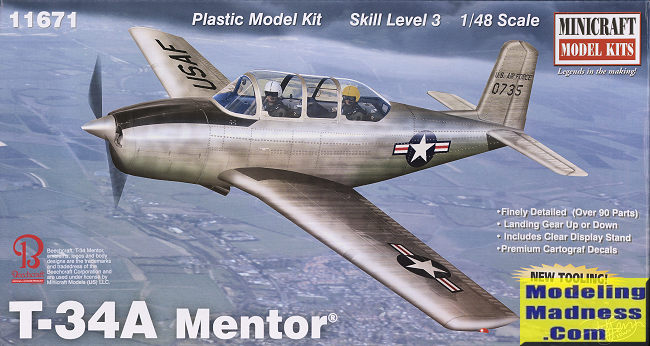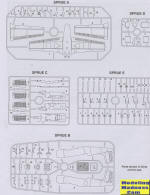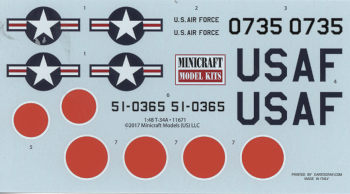
| KIT #: | 11671 |
| PRICE: | $ |
| DECALS: | Two options |
| REVIEWER: | Scott Van Aken |
| NOTES: | 2018 release |

| HISTORY |
The Beechcraft T-34 Mentor is an American propeller-driven, single-engined, military trainer aircraft derived from the Beechcraft Model 35 Bonanza. The earlier versions of the T-34, dating from around the late 1940s to the 1950s, were piston-engined. These were eventually succeeded by the upgraded T-34C Turbo-Mentor, powered by a turboprop engine. The T-34 remains in service more than six decades after it was first designed.
After extensive testing, the USAF ordered the Mentor into production as the T-34A in early 1953. The first production T-34A was delivered to Edwards Air Force Base, California, in October 1953 for evaluation, and deliveries to the Air Training Command (ATC) began in 1954. The T-34A commenced service as USAF's initial primary flight trainer at "contract" pilot training air bases across the southern United States, replacing extant North American AT-6 Texan trainers. Following training in the T-34A, USAF pilot trainees would advance to the North American T-28A Trojan for intermediate training.
The T-34A Mentor remained the standard USAF primary trainer until the introduction of the Cessna T-37 Tweet jet trainer in the late 1950s, replacing both the T-34A and T-28A. This also coincided with ATC's implementation of the Undergraduate Pilot Training (UPT) syllabus at various air force bases in the United States under ATC claimancy and phaseout and closure of the contract pilot training air bases. As they were replaced by T-37s, many T-34As were turned over to USAF aero clubs at air force bases in the United States and USAF air bases overseas. In all, the USAF acquired 450 T-34As.
As the U.S. Air Force replaced the last of their T-34As at the beginning of the 1960s, their role taken over by the propeller-driven T-41 Mescalero and the T-37 Tweet primary jet trainer in UPT, those T-34As not allocated to USAF aero clubs or marked for foreign military sales or transfers were turned over to the USAF Auxiliary, the Civil Air Patrol, for use as search aircraft. However, the T-34A's low wing limited its utility in an aerial search and rescue role, and maintenance issues, particularly expensive wing spar repairs that became apparent in the late 1990s, resulted in the last of the former USAF T-34As being withdrawn from CAP service by 2003.
The U.S. Navy kept the T-34B operational as a Naval Air Training Command initial primary trainer at the former Naval Air Station Saufley Field, Florida until the mid-1970s and as a Navy Recruiting Command aircraft until the early 1990s when the last examples were retired as an economy move. Others continue to remain under U.S. Navy control as part of flying clubs at naval air stations and marine corps air stations.
| THE KIT |
 It
is nice to see this one done in a larger scale. I have a feeling that this may
well be based on their earlier civilian Beechcraft as all the surface detailing
is raised. The cockpit consists of a floor with molded on side consoles onto
which a right and left side are attached. These sides include parts of the nose
gear well which, when added to the bit in the floor piece, will make up the
three piece well. A rear section completes the tub. The instrument panels are
devoid of dial detail and no decals are included. Each of the two seats is five
parts with the cushions containing belt detail. These, the control sticks and
trim wheels are added to the cockpit before the interior is trapped between the
two fuselage halves.
It
is nice to see this one done in a larger scale. I have a feeling that this may
well be based on their earlier civilian Beechcraft as all the surface detailing
is raised. The cockpit consists of a floor with molded on side consoles onto
which a right and left side are attached. These sides include parts of the nose
gear well which, when added to the bit in the floor piece, will make up the
three piece well. A rear section completes the tub. The instrument panels are
devoid of dial detail and no decals are included. Each of the two seats is five
parts with the cushions containing belt detail. These, the control sticks and
trim wheels are added to the cockpit before the interior is trapped between the
two fuselage halves.
One then has to find room for the 28 grams of weight and frankly, it will be a challenge. In the front a two part forward cowling allows you to trap the prop shaft in place. After gluing in the small rudder fillet, the wing spar can then be added. Landing lights are then added to the lower wing before it, and the upper halves are joined to the fuselage.
Next the tailplanes are joined together and installed along with the long exhaust pipes. There are four pieces to the canopy/windscreen combo. These appear to be too thick to have the canopies posed open. Perhaps a single piece would have been better.
The build then moves to the landing gear. Frankly, the
gear appears to be quite scale, which means I have my doubts if the nose gear
will be able to hold up the 28 grams of weight. I'm sure SAC will provide metal
replacements. The kit can be built gear up if one wishes and a display stand is
provided for that option. No specific location for the stand mounting hole is
molded in so you basically pick a spot and drill. To do gear up, the door
 mounting
tabs will need to be removed. A four piece prop that consists of two separate
blades and a forward and aft spinner are provided. You are given a choice
between a blunt and more pointed spinner. Check your references.
mounting
tabs will need to be removed. A four piece prop that consists of two separate
blades and a forward and aft spinner are provided. You are given a choice
between a blunt and more pointed spinner. Check your references.
Instructions are very well done and could probably have been reduced from the 23 construction steps as some only show one or two pieces being attached. Still, they are nice to have. There are two rather insipid markings options. One is the box art plane which is a YT-34A. The other is a generic JASDF plane, also in unpainted metal. You will need to paint the anti-glare panels and wing walk areas. Fortunately Caracal Models has two very nice aftermarket sheets that will provide something more interesting.
| CONCLUSIONS |
We have waited a long time for this one and I am sure it will sell well. Nose weight in these sorts of planes is probably the greatest issue as I recall doing several Hasegawa 1/72 versions and struggling with the weight issue. Unless one wants a very plain aircraft, most will go the aftermarket route. I do like the display stand being included and this will very much take care of the nose weight problem.
| REFERENCES |
https://en.wikipedia.org/wiki/Beechcraft_T-34_Mentor
July 2018
Kit courtesy of Mastercard. If you would like your product reviewed fairly and fairly quickly, please
contact the editor
or see other details in the
Note to
Contributors.
Back to the Main Page
Back to the Review
Index Page
Back to the Previews Index Page